COMMUNION WINE. – Frederick A. Page, of Providence, has been sentenced to a fine of $20 for selling a quantity of wine for communion service, the Court having decided that such a use is neither “medicinal,” nor “artistical.”
The North Star (Rochester, New York), July 6, 1849
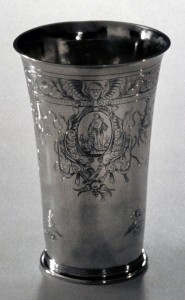 Beaker
Beaker
HH (unidentified maker)
New Yorkor Albany, New York; about 1690
Silver
Museum purchase with funds provided by Henry Francis du Pont 1958.95.1
Beakers of this form originated in Holland and were also made in New York and New Jersey for serving communion wine in the Dutch Reformed Church. Examples with similar allegorical figures representing Faith, Hope, and Charity can be found at the First Church of Albany. This beaker was owned by Jan Lansing, of Albany, New York, and was passed down to his daughter, Englette, who married lawyer and Commissioner of Indian Affairs Evert Wendell.
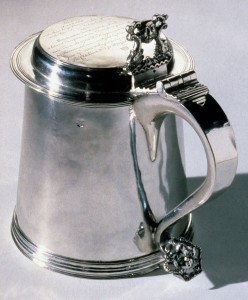 Communion tankard
Communion tankard
Edward Winslow
Boston, Massachusetts; 1690–1703
Silver
Gift of Henry Francis du Pont 1959.3365
This tankard first belonged to the Sprague and Chester families of Massachusetts and bears their coat of arms. It was donated to their church along with other vessels for the communion service. An inscription on the underside states, “The gift of / Capt Richard Sprague / to the Church of Charlestown 1703.” The lid gives further details: “This / TANKARD / with three large Flaggons where give / to the Church in Charlestown / by / RICHARD SPRAGUE, Esq. \ r / a liberal Benefactor to the Church.”
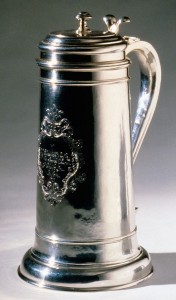 Flagon
Flagon
Peter Oliver
Boston, Massachusetts; dated 1711
Silver
Inscribed “Mrs. Elizabeth Wensley / To the Second Church/ of Christ In /Boston/ 1711”
Bequest of Henry Francis du Pont 1966.1052
Jerusha, the first wife of Peter Oliver, who made this flagon, was a daughter of Puritan minister Increase Mather, an important figure in early Massachusetts Bay Colony history. Peter’s second wife, Hopestill, was the daughter of Elizabeth Wensley, whose name appears on the vessel. The flagon was made as a gift to the Second Church of Christ in Boston after Elizabeth’s death in 1710.

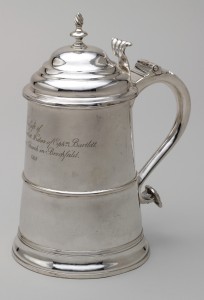 Communion wine tankards
Communion wine tankards
Paul Revere, Jr.
Boston, Massachusetts; 1772, dated 1768
Silver
Inscribed “The Gift of / Mary Bartlett Widow of Eph \ m Bartlett, / to the third Church in Brookfield/ 1768”
Gift of Henry Francis du Pont 1957.859.1-.6
This set of six tankards is considered to be among Winterthur’s most prized treasures. They were made by Paul Revere Jr., who is known for his patriotism during the American Revolution. The set was ordered from Boston silversmith Jonathan Trott by Jedidiah Foster, executor of the estate of Mary Bartlett and deacon of the church she attended. Period records state that Trott paid Revere in 1772 for the completion of six wine quart tankards. The inscription, dated four years earlier, commemorates Mary’s gift to the Third Church at Brookfield, Massachusetts.
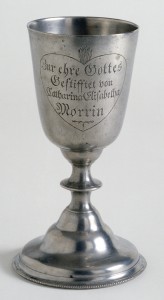
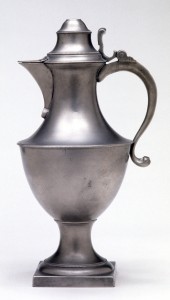 Flagon and chalice
Flagon and chalice
William Will
Philadelphia, Pennsylvania; about 1795
Pewter
Chalice inscribed “Zur ehre Gottes / Gestifftet von / Catharina Elisabetha / Morrin” (Catharine Elizabeth Morrin to the Glory of God)
Gift of Henry Francis du Pont 1958.649; Museum purchase with funds provided by Joseph France 1958.24
These two vessels have much in common, in terms of form, with the flagon and chalice in a more complete William Will communion service, in another collection, that retains its original ewer and basin. That service was presented (1789–94) by Aaron Levy to the Salem Lutheran Church of Aaronsburg, Pennsylvania.
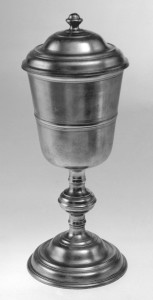 Chalice
Chalice
Johann Christoph Heyne
Lancaster, Pennsylvania; 1756–80
Pewter
Gift of Mr. Edgar Sittig 1953.97a,b
Communion vessels represented the pinnacle of the pewterer’s art in America. This chalice, which retains its original lid, was made by Johann Christoph Heyne, who arrived in Philadelphia from Saxony in 1742. An active member of the church, Heyne traveled to Ireland in 1747 to help establish the Moravian church in that country. In 1752 he and his wife settled in Lancaster, Pennsylvania. Most surviving pewter by Heyne was made for ecclesiastical use.
 Pair of two-handle cups
Pair of two-handle cups
Thomas D. Boardman
New York, New York; 1825–27
Pewter
Gift of Mr. Charles G. Dorman 1976.187.1, .2
Although handleless versions are more common, matched pairs of cups with handles were sometimes part of ecclesiastical services. The First German Baptist Church in Wilmington, Delaware, owned this pair as well as a related flagon. The set was then acquired by a member, Albert W. Walther, the donor’s grandfather, in whose family it remained until acquired by Winterthur.
 Catalogue of church ornaments, vestments, material for vestments, and regalia, pp. 16-17
Catalogue of church ornaments, vestments, material for vestments, and regalia, pp. 16-17
New York, Cincinnati, and St. Louis: Benziger Brothers, 1881
Printed Book and Periodical Collection, Winterthur Library NK1657 B47 1881 TC*
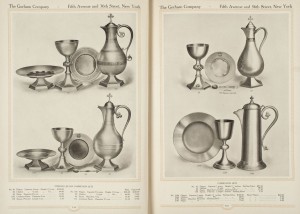 Ecclesiastical catalogue, pp. 30-31
Ecclesiastical catalogue, pp. 30-31
New York, New York: Gorham Manufacturing Company, 1914
Printed Book and Periodical Collection, Winterthur Library NK1657 G66 TC
During the 1800s, illustrated trade catalogues became increasingly available in Europe and America. The objects in the catalogues shown here reflect neo-gothic and neo-Renaissance tastes and would have appealed to conservative churches. Benziger Brothers began publishing illustrated catalogues of church ornaments in 1873, and they also sold prayer books, devotional guides, and moral fiction. Gorham Manufacturing Company produced high-end wares for use in elegant homes in addition to supplying church silver.
Related Themes:
